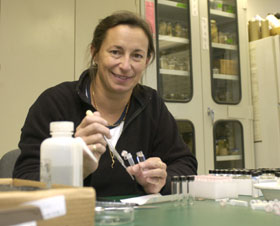|
This is an archived article.
For the latest news, go to the Advance Homepage
For more archives, go to the Advance Archive/Search Page. |
||
|
Teaching, Learning About Tapeworms
"They're like treasure chests of the sea," says Janine Caira, looking at the thousands of jars of pickled fish guts that line the shelves in her lab. "The spiral intestine is where you find all the tapeworms," she adds.
Caira, a professor of ecology and evolutionary biology and award-winnin g parasitologist, specializes in the evolution and diversity of the tapeworms that live in the digestive tracts of sharks and stingrays. The tapeworms are beautiful, she says. "They're like flowers. The more work we do on them, the more diversity we see, not just in terms of how many species there are, but their spectacular morphology." Caira says the centimeter-long parasites can provide information on a variety of aspects of the biology of their hosts, including migrations, feeding habits, evolution, and predators. They spend their entire adult lives attached to the surface of the gut of their shark host. "The part of the body they use to attach to the gut of the shark or ray is incredibly elaborate," she says. "And the more we look, the more spectacular forms we see." What intrigues Caira "is that each species of shark and ray hosts a completely different fauna of tapeworm," she says. "If I looked at one ray, that ray would host many different species of tapeworms. And those species would only be found in that ray. The species of a shark can be identified just from the spiral valve of its gut, with its particular fauna of tapeworms," she says. Caira's work has taken her on expeditions across the globe in search of tapeworms from previously unexamined species of sharks and rays. "We work with local fishermen, helping them clean their fish," she says. Usually she walks away with just the gut. Caira tries to arrange travel during the summer and intersession. She and a handful of students just returned from Senegal, and the last two summers were spent in Borneo. Her work has taken her to destinations including Australia, Colombia, Madagascar, Mexico, New Guinea, and Thailand, to name a few. Her work has resulted in the discovery of more than 50 species of tapeworm new to science, which has furthered the understanding of the diversity of sharks and rays. Caira's enthusiasm for her subject is infused into her teaching. In her lab, undergraduate researchers work alongside doctoral students and examine tapeworms from species that have never been seen before. They get to describe and name them. "I like seeing the sparkle in their eyes that appears when they 'get it'," she says. "I also like presenting information that is completely unknown to them, that they weren't at all expecting. When they take a class in parasitology or invertebrate zoology and learn the elaborate life cycles of these organisms, you can see how amazed they are. I like sharing that." Caira was recently honored with the Distinguished Alumni Professorship Award. The award recognizes "an excellent teacher as well as an individual of international reputation whose scholarship reflects substantial credit to the University of Connecticut." Professor Gregory Anderson, head of the ecology and evolutionary biology department, says Caira is "a prototype for the award. She does it all; working incredibly hard, and making significant contributions to all three areas the award demands - teaching, research, and service." Florian Reyda, a doctoral student in Caira's lab, says she is a "tremendous researcher and educator." He recalls a quote from Chaucer's Canterbury Tales in which a clerk is described with the phrase, 'Gladly would he learn, and gladly would he teach.' "The same applies to Dr. Caira," he says. Kirsten Jensen, who earned a Ph.D. at UConn says, "Janine can make things happen. She gets students excited about invertebrates and parasites, initiates and guides international collaboration, leads major field expeditions, has made lasting contributions to the field, and has never failed to win fishermen from around the world for the cause of shark and ray tapeworms." Jensen is now an assistant professor in the ecology and evolutionary biology department at the University of Kansas. Kent Holsinger, a professor in the department of ecology and evolutionary biology, says Caira is widely regarded as one of the finest teachers in the department. "Advisees who have taken her courses have always raved about her enthusiasm, her concern for students, her fairness, her rigor, her depth of knowledge, and her ability to make parasites and invertebrates interesting," he says. "She demands a lot from her students, but not half as much as she demands from herself." Caira, who joined the UConn faculty in 1985, received a bachelor's degree in zoology and a master's in entomology from the University of British Columbia. She earned her Ph.D. in parasitology at the University of Nebraska-Lincoln. She was recognized as a University Teaching Fellow in 1995, received an Alumni Association Distinguished Teaching Award in 1999, and in 1998 was named the most outstanding North American parasitologist by the American Society of Parasitologists. |

